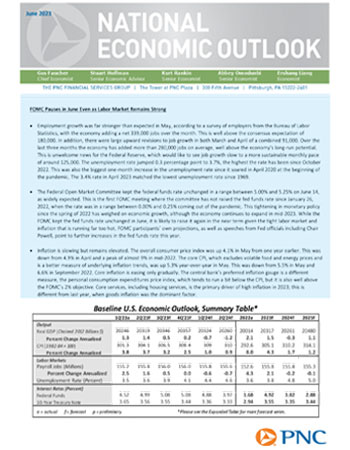The information contained in this site, is to the best of PNC Bank's knowledge, correct and accurate, but PNC Bank does not represent, warrant or guarantee its accuracy. Any downloading of material contained in this site or of any site linked to this site may be a violation of federal trademark and copyright laws.
PNC National Economic Outlook
January 2024
GDP Growth Remains Strong in the Fourth Quarter as Labor Market Continues to Hold Up
Real GDP increased a strong 3.3% at an annualized rate in the fourth quarter of 2023, according to the advance estimate from the Bureau of Economic Analysis. (The release came after the January forecast was prepared.) Growth was 4.9% in the third quarter. Growth for all of 2023 on a Q4-to-Q4 basis was 3.1%, much better than the 0.7% in 2022, and about double the economy’s long-run potential. Growth was broad-based in the fourth quarter, with all major components adding to growth. Real consumer spending increased 2.8% in the quarter, adding 1.9 percentage points to annualized growth. Business fixed investment rose 1.9%, adding 0.3 percentage point to growth. Housing investment increased 1.1%, although its contribution to growth was minimal. With mortgage rates falling at the end of 2023 housing investment has now increased in two consecutive quarters, after nine straight quarters of decline. A shrinking trade deficit added 0.4 percentage point to growth in the fourth quarter, as exports rose more than imports (up 6% and 2%, respectively). Increased government spending added 0.6 percentage point to fourth quarter growth. Inventories were a modest positive for fourth quarter growth.
The jobs report for December 2023 came in stronger than expected. Employment as measured in a survey of firms rose by 216,000 over the month, above the consensus expectation of around 170,000. However, there were large downward revisions to job growth in October and November of a combined 71,000. The private sector added 164,000 jobs in December, with government employment up by 52,000. For all of 2023 the U.S. economy added an average of 225,000 jobs per month, down from an average of 399,000 in 2022.
The unemployment rate held steady at 3.7% in December, with both employment and the labor force contracting. The unemployment rate has been below 4% for almost two years, the longest such stretch since the late 1960s. Employment in a survey of households (different from the survey of employers) fell by 683,000 in December, after an increase of 586,000 in November; employment is much more volatile in the household survey. There were average job losses of 122,000 in the household survey in the three months through December. The number of people in the labor force—either working or looking for work in the household survey—fell by 676,000 in December. The labor force participation rate—the share of adults in the labor force—fell to 62.5% in December from 62.8% in November. This is the lowest the labor force participation rate has been since February. If sustained, the drop in the labor force participation rate could lead to a further tightening in the job market.


